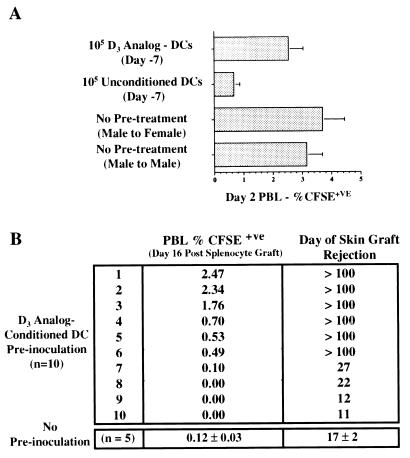Figure 4.
(A) A group of five male B6 and three groups of five female B6 mice were inoculated with CFSE-labeled male B6 splenocytes. Two days later grafted cells were quantified. Results are expressed as mean ± SD for each group. Male and female recipients that had received no pretreatment had 3.15 ± 0.54% and 3.70 ± 0.75% CFSE+ve cells, respectively (P = 0.2). Females inoculated 7 days previously with 105 unconditioned male B6 DCs had 0.67 ± 0.20% CFSE+ve cells (P = 0.0002 compared with male to male group). Females preinoculated with 105 D3 analog-conditioned DCs had 2.54 ± 0.50% CFSE+ve cells (P = 0.1 compared with male to male group). (B) Ten female B6 mice received 105 D3 analog-conditioned male B6 DCs followed 7 days later by CFSE-labeled male B6 splenocytes. A control group of five female B6 mice received labeled splenocytes without DC preinoculation. The percent of CFSE+ve PBLs 16 days later was determined in each animal (Center). Six of 10 animals preinoculated with D3 analog-conditioned DCs had levels of labeled cells greater than the control group. Seven days later all animals were grafted with male B6 skin and time to graft rejection was determined (Right). The control group rejected male skin grafts between 15 and 19 days posttransplant. Six of 10 DC-treated animals retained skin grafts indefinitely (>100 days) whereas the remaining four rejected grafts between 11 and 27 days posttransplant. Indefinite skin graft survival correlated with prolonged retention of male splenocytes in the group preinoculated with D3 analog-conditioned DCs.

